Learning how to sleep with lower back pain, knee pain and osteoarthritis in other joints can be critical when it comes to finding pain relief. Poor quality sleep can actually increase your sensitivity to pain. But getting better sleep may feel easier said than done right now. Learn 5 strategies on how to sleep better with osteoarthritis in this article.
This article contains affiliate links that provide us with a small compensation if purchases are made through our links at no extra cost to you.
Do you experience osteoarthritis pain or stiffness at night? Does joint pain wake you up or make it difficult to fall asleep?
If you’re wondering how to sleep with arthritis pain in the knee or even how to sleep with lower back pain- you are in the right place.
Sleep is incredibly important, especially when you have chronic joint pain related to osteoarthritis. Here are a few reasons why:
- Moreover, getting less than or more than optimal sleep duration of 7–8 h has been associated with increased levels of inflammatory markers such as C-reactive protein (CRP) and interleukin-6 (IL-6) (Park et al 2019)
- There is strong evidence that having short or disturbed sleep can cause hyperalgesia (i.e., an increased sensitivity to painful stimulation) and the development or exacerbation of spontaneous pain symptoms (e.g., muscle pain, headache) (Haack et al 2019)
You can improve your sleep
If you have joint pain or stiffness, you may experience difficulty sleeping. Whether the pain wakes you up, the aching prevents you from falling asleep and/or the pain makes you anxious- there is hope.
Take it from the wins members from Adventurers for Life have experienced. Whether you have arthritis in the knee(s), hip(s), lower back- it’s possible to improve your sleep.
Implementing the right strategies, building strength in the right areas and decreasing overall pain can be incredibly powerful. If you can improve your sleep, your life can change.
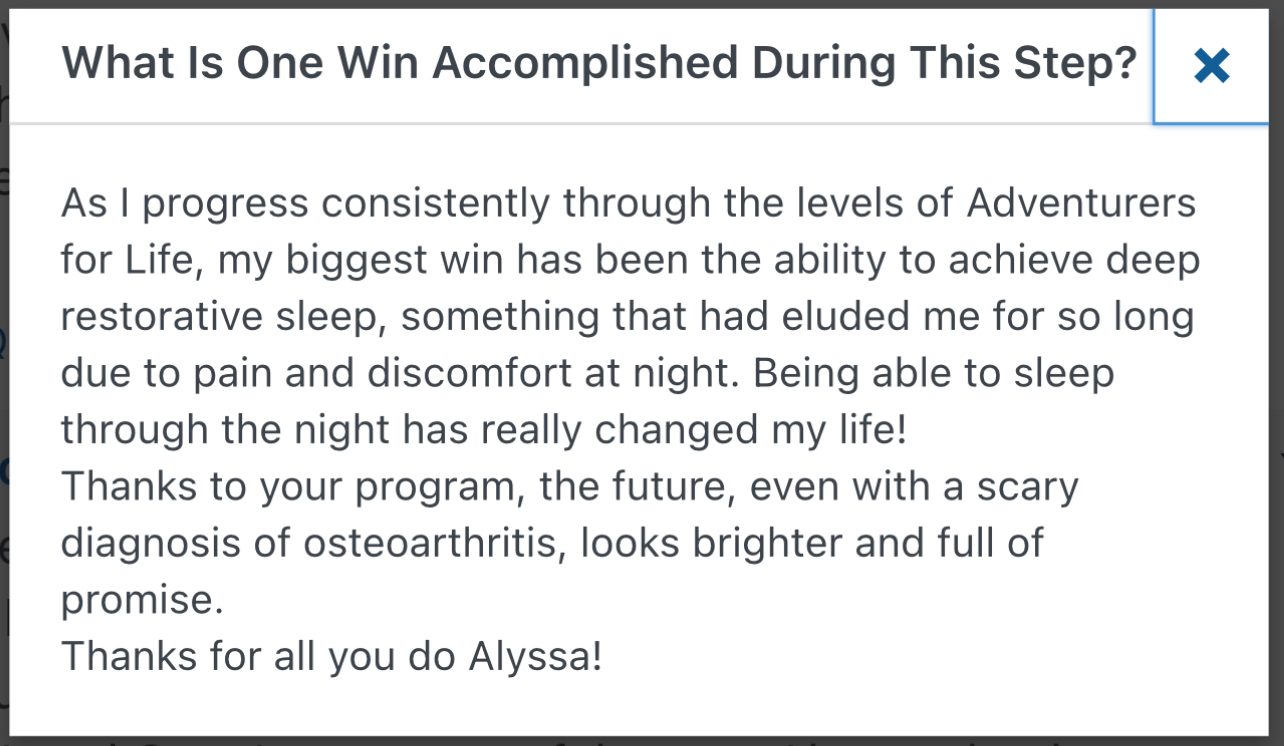


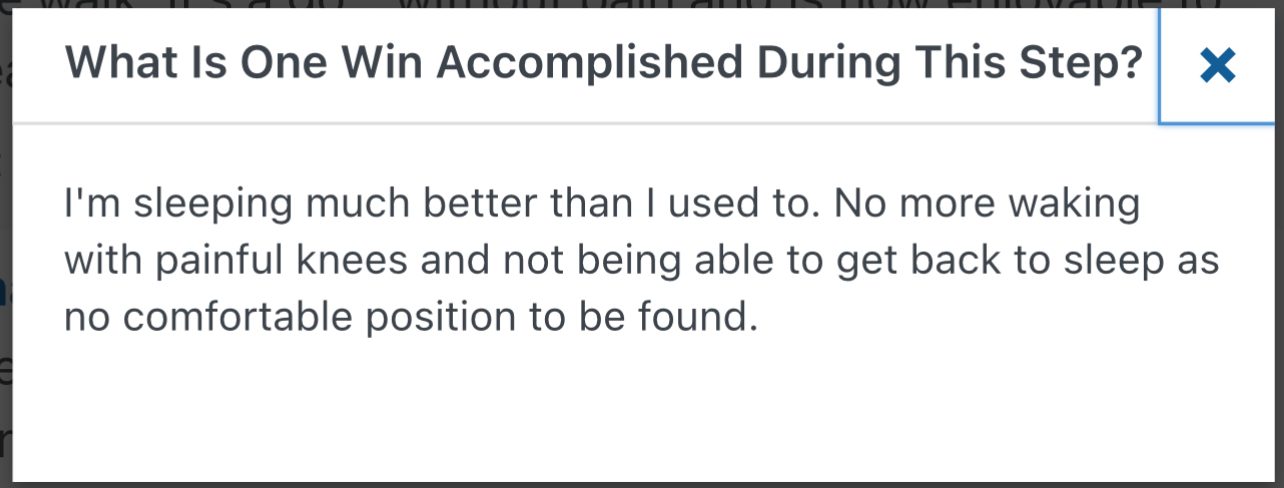
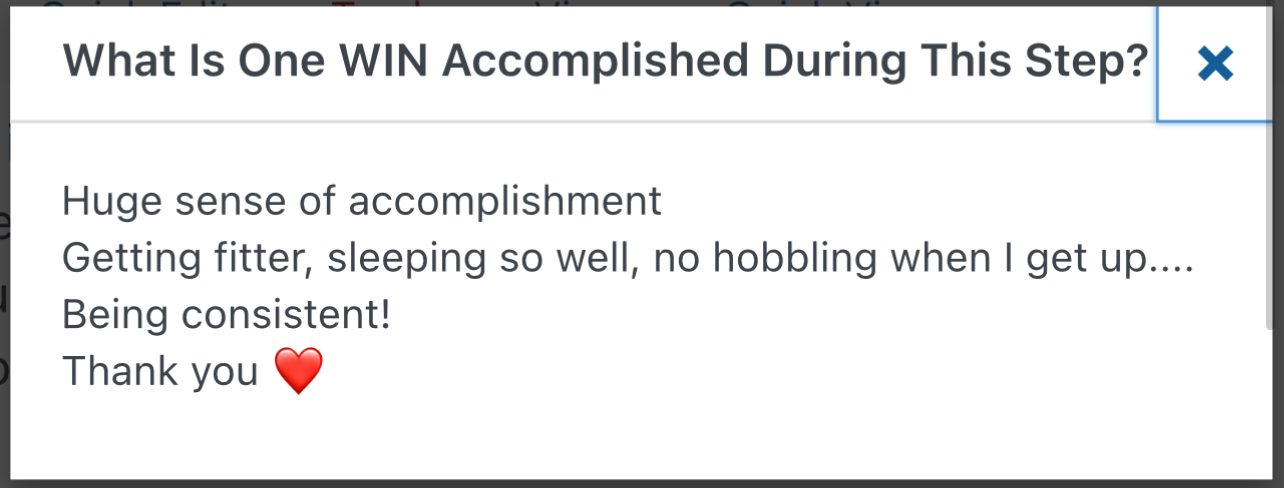
You're Not Alone
I was talking with an Adventurers for Life member recently who was dealing with occasional knee pain at night. This pain would wake her up at night and make it difficult to fall back asleep.
One important thing I told her and frequently tell many others experiencing pain at night is to think about the day that you just had and maybe even the day prior. Did anything change?
Did you try a new activity? Did you move more or less than you usually do? Did you eat certain foods you don’t normally?
When she got to thinking, earlier that day she realized she had significantly increased her activity. She had set an alarm to help her remember to get up every 20 minutes. This was significantly more movement than she typically does.
When it comes to movement, your joints need time to get used to more of it. Sudden increases in activity can be one way to irritate your joints, especially at night.
There may not always be an obvious reason as to why you might be experiencing pain at night. When looking at how to sleep with lower back pain and other arthritis aches, it’s important to know what can lead to increased pain so you can work to prevent it.
Let’s look into the 5 strategies on how to prevent arthritis pain when sleeping. You can also follow along with this video below:
How to sleep with lower back pain and other arthritis aches: 5 strategies
There are ways to combat night pain and stiffness so you can get better sleep, even with arthritis!
If you have been told you have degenerative disc disease, spinal stenosis or have been dealing with chronic back pain these strategies can be very helpful.
If you’re reading this and have knee osteoarthritis, hip osteoarthritis, or other joint aches/pains these strategies can work for you too!
As a physical therapist, I have helped hundreds of people with osteoarthritis find pain relief both during the day and at night. I have found one common factor that typically leads to the highest success. That is…taking ACTION.
Focus on one or two of these strategies below to get started with:
1. Avoid Overdoing It
Just like in the example explained above, overactivity can be one of the leading causes of pain at night in my experience.
If you heard movement can actually be helpful for exercise, it may lead you to think that the more movement you do, the better you will feel.
This is not always the case. Taking the example above, if you are relatively sedentary- suddenly trying to increase your movement significantly, may actually leave you in more pain.
You have to give your joints time to get used to moving more.
What are some ways you can prevent overdoing it?
For the example discussed at the beginning of the article, setting an alarm instead for every hour, may be much more manageable when starting out. It may also lead to less pain at night.
Another example when looking at how to reduce lower back pain at night specifically could be- avoiding a sharp increase in activities that require bending over like gardening or those activities that require lifting- i.e packing up and moving boxes.
There are absolutely ways to help train your body to tolerate these activities to help reduce irritation. You can also consider activity pacing. Instead of weeding the whole garden in one day, you can split it into sections.
Here is a video below discussing how to know if you are overdoing it and prevent it from happening.
2. Make sure you're moving enough
I know it may seem contradictory to number one, but it’s all about balance. This can be one of the toughest aspects when dealing with pain from osteoarthritis. It’s important to be aware of how much activity is too much for your joints but also what is not enough.
Movement is crucial when it comes to finding pain relief, especially at night. How much you move during the day can dictate level and presence of some night pain.
First it’s important to understand why movement is good for arthritic joints in the first place. Here is an article detailing the benefits.
Secondly, finding movements that don’t flare up your pain is really important, for obvious reasons.You likely aren’t going to be jazzed about doing movements that increase pain nor will you likely be consistent.
But I promise you, movement can be so powerful when you find the right ones. They don’t have to be complicated.
Moving frequently can help to keep stiffness at bay and can help to reduce irritation significantly both during the day and at night.

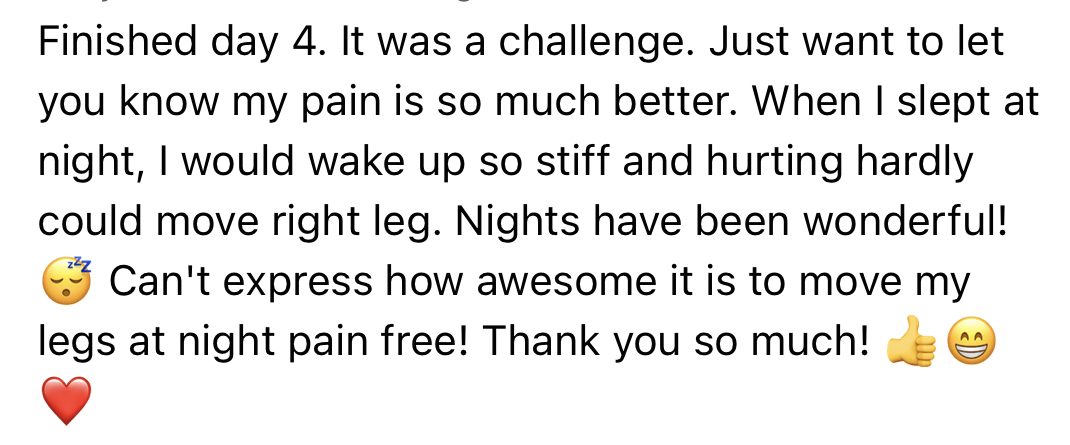
If you want to skip ahead and start making a change to your pain right now, the free 4 Day Arthritis Friendly Workout Challenge equips you with follow along workouts that are arthritis friendly as well as other helpful pain relieving strategies. Find out more below.
A good rule of thumb to start with is making sure you are moving every 1-2 hours- whether that’s getting up and moving around or completing simple seated movements.
If you spend a lot of time sitting throughout the day or on your feet in one position, this can increase your pain at night. Motion is lotion!
3. Heat and/or ice
One of the common questions I get is “what is better, heat or ice, for arthritis pain?”
The answer, it depends largely on your personal preference. I do find anecdotally, most people have more luck with heat, especially with chronic pain.
One study examined the benefits of heat on those with knee osteoarthritis in particular. Findings are detailed below.
"It was found that heat application every other day decreased pain and disability of the patients with knee osteoarthritis. Also, heat application was found to improve the subdimensions of quality of life scores of physical function, pain and general health perception of patients"
Yildirim et al 2010
It is thought that heat can help to contribute to muscle relaxation while improving blood flow. When it comes to osteoarthritis, muscles can get tight as a response to pain and can become irritated, especially at night.
In learning how to sleep with lower back pain and other arthritic aches, muscle relaxation can be very important.
Ice on the other hand is thought to “numb the pain, decrease swelling, constrict blood vessels and block nerve impulses to the joint (Brosseau et al 2003).
Ice tends to feel better when dealing with significant levels of pain and/or swelling.
Both can be effective in different ways, so ultimately it comes down to personal preference and what your body seems to respond best to.
Using either right before bed can be helpful in reducing arthritis night pain. But, PLEASE don’t fall asleep with either on in order to avoid any burns or other reactions/injuries.
4. Topical Ointments
Topical pain relieving ointments can be effective at reducing pain, especially at night. The good news is most of these topical ointments have significantly less side effects than most pain medications.
There are many different brands and types of these but here are some common ones that can be helpful. Please remember everyone will respond differently to each one of these so you may need to try a couple before finding one that works for you.
These are just a few examples and other brands certainly exist. CBD creams are another avenue people typically have luck with too if they are available to you.
It is important to check with your doctor to make sure the ingredients in these products won’t interact with medications you are taking or other medical conditions you have.
With a topical cream, there is always a risk for a reaction such as a rash so it is important to try the cream during the day to make sure you don’t have a reaction before trying at night.
Most of these creams work if you rub on or near the joint(s) or muscles that are most painful but please use as the cream directs.
5. Controlling your pain during the day
I know this one, you may be saying “well duh, that would be great if I could do that!” But hear me out.
A lot of different people I talk to who are dealing with osteoarthritis pain, try to push through high levels of pain specifically during movement because they are told they “have to exercise” and it makes sense more is better.
Sometimes, you may not have a choice in reducing movement, i.e if you have to stand or walk all day for work. Using one of two strategies to reduce pain severity and/or frequency can help to reduce night pain.
Here are some articles that may help depending on what is flaring up your pain:
- Night pain after traveling? Try this to reduce stiffness on the plane or in the car.
- Walking on concrete all day? Take a look at this article discussing the best shoes for the job.
- Lacking variety in your movement? Read this article for simple tips on how to include it.
- Know your diet could use some cleaning up? Learn the best anti inflammatory foods here!
Using the other strategies discussed and taking action when it comes to your pain can be one of the best ways to get better sleep.
The progress may be slow and steady but monitoring pain levels to see if severity or frequency of pain is decreasing is a great way to show it.
I’m by no means saying controlling pain is an easy feat but there are ways to help make it possible. Hope these suggestions can help you get on the right path!
How to sleep with lower back pain, knee pain, and other arthritic aches
Following these five tips above can give you a great start towards reducing arthritis night pain.
Each person is going to have a different experience with pain as well as different triggers.
It’s important to try to identify what is flaring up your pain. It may not always be straightforward and there may be multiple things contributing. But understanding what can increase pain may be a good start.
If you are unsure where to start when it comes to finding pain relief, preventing overdoing it, and getting started on your own adventure, watch this video below!
References:
Alyssa Kuhn
Disclaimer: This post is for general informational purposes only. It should not be used to self-diagnose and it is not a substitute for a medical exam, cure, treatment, diagnosis, and prescription or recommendation. It does not create a doctor-patient relationship between Dr. Kuhn and you. You should not make any change in your health regimen or diet before first consulting a physician and obtaining a medical exam, diagnosis, and recommendation. Move Well Age Well, LLC and Dr. Alyssa Kuhn, PT, DPT are not liable or responsible for any advice, course of treatment, diagnosis or any conclusions drawn, services or product you obtain through this post, video or site. Complete all exercises at your own risk.
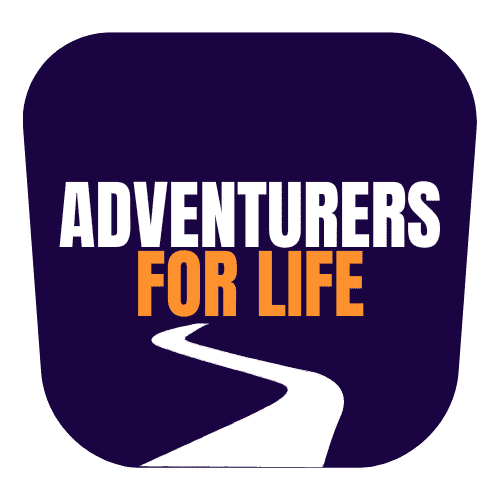
If you are looking to regain your active life but are unsure where to start, join the revolutionary membership, Adventurers for Life. This is a step-by-step path that not only will help you find pain relief but will help you unlock adventure. You’ll get workouts, tests to pass to make sure you are on the right track, community events and MORE.




